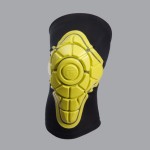updated 3may14
When you’re the minority player in the arena, you work with the leftovers and adapt products from other sports that are more popular. Such is the case of the telemarker looking for knee pads. When you’re dropping a knee, it’s not a matter of if you bash your knee on a rock, stump, or from a crash at speed, it is only a matter of when.G-Force is in the business of making protective gear for all manner of human joints and bones. Their protective pads are made from a foam similar to other brands like POC and Spyder. G-Form calls it RPT™ – Reactive Protection Technology – a composite of PORON®XRD™ material and proprietary G-Form materials and technology that instantly stiffens upon impact and absorbing over 90% of the energy. What What distinguished their impact protection is the flexible form it takes. By breaking a surface into several pieces, bonded to a form fitting sock that you, for our purposes, slide around your knee, G-Form allows their pads to adapt and maintain contact over a large surface area while the joint is moving.
Most other knee-pads are stiff and while they provide protection over a large range of movement, they are most effective in a direct hit, which has a limited aspect. G-Form pads provide protection from a far greater range of angles, while also bending with your body in motion.
As a regular user of knee-pads I find that they eliminate the discomfort that can come from kneeling on a hard, or cold surface, and most especially a sharp one (let alone falling on them). This can range from working on the car, or house chores, to backcountry skiing. Kneel a few times in the snow and you’ll realize you don’t even need to be a telemarker to appreciate the value of knee-pads.
The biggest issue many people have with them is their bulk – they don’t fit too well under most pants. Enter G-Form’s protective padding, which molds to the shape of your joint, creating less bulk while increasing the surface area of protection.
What are the cons? For skiers, you’ll probably be wearing long underwear, so the question is whether to put these knee-pads under or over? If over your long-johns, there is a tendency for the sleeve to creep down your leg as the fabric on the long johns stretches. Under and they still move, though not as much, but might also tend to abrade the material. YMMV.
update 3may14
After using these throughout the Wimpter of 2014 I can confirm the G-Form knee pads are best worn next to skin. When worn over long johns they will inevitably slide down your leg; next to skin they tend to stay where you place them.
end update
G-Form
Knee Pads
MSRP: $60
Sizing (circumference around knee): From sizes XXS (24cm/9½”) – XXXL (51cm/20″)
© 2013


3 comments
Besides the noted issues with long underwear which were too preventative for me, the other downside for tele use is that the foam gets much firmer when cold. While still more pliable than a hardshell pad it is not nearly as nice as use when temps are moderate. I’m sticking with my hardshell pads.
My issue with kneepads of old is that it makes my kneecap track funny. After a days worth of skiing, it makes the knee feel irritated. No kneepad = no irritation.
Any ideas whether this affects the kneecap similarly?
Can’t say if these knee pads help with “tracking” or not. I can say that breaking up the pads into smaller pads allows more natural movement of the knee and they don’t feel like a giant pad on front, more like an extra thick layer of protection that conforms to the movements of your legs around the knee better. They’re my go-to set of knee pads these days, for more than just skiing.